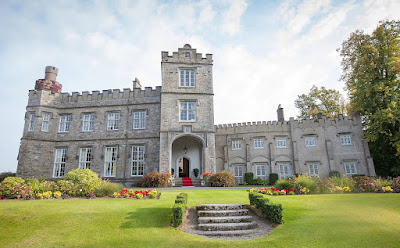THE BARONS ANNALY WERE MAJOR LANDOWNERS IN COUNTY DUBLIN, WITH 3,954 ACRES
HENRY WHITE (1791-1873), of Woodlands (otherwise Luttrellstown), County Dublin, and subsequently of Rathcline, County Longford, was the fourth, but only surviving son of Luke White, bookseller, of Woodlands.
Having succeeded to the Longford estates of his next elder brother, Luke White, in 1854, he was elevated to the peerage, in 1863, in the dignity of BARON ANNALY (third creation), of Annaly and Rathcline, County Longford.
His lordship married, in 1828, Ellen, daughter of William Soper Dempster, by Hannah, only daughter and heir of John Hamilton Dempster, of Skibo Castle, Sutherland, and had issue,
LUKE, his successor;He died at Sunbury Park, Middlesex, and was succeeded by his eldest son,
Henry;
George Frederick;
Francis Samuel;
Charles William;
Robert;
Eleanor Eliza; Emily Beaujolais.
LUKE, 2nd Baron (1829-88), KP, who wedded, in 1853, Emily, daughter of James Stuart, and had issue,
LUKE, his successor;His lordship was succeeded by his eldest son,
Henry Frederick;
Charles James;
Robert;
Francis William;
Ellen Harriet; Alice Emily; Violet.
LUKE, 3rd Baron (1857-1922), GCVO JP DL, who wedded, in 1884, Lilah Georgiana Augusta Constance, daughter of Henry, 3rd Viscount Clifden, and had issue,
LUKE HENRY, his successor;His lordship was succeeded by his son,
Lilah Charlotte Sarah; Lucia Emily Margaret.
LUKE HENRY, 4th Baron (1885-1970), MC JP,
- Luke Robert White, 5th Baron (1927–90);
- Luke Richard White, 6th Baron (b 1954).
LUTTRELLSTOWN CASTLE, Clonsilla, County Dublin, dates from the early 15th century (ca 1420).
It has been owned variously by the eponymous and notorious Luttrell family; the bookseller Luke White his descendants the Lords Annaly; the Guinnesses; the Primwest Group; and, since 2006, JP McManus, John Magnier and Aidan Brooks.
The Castle has hosted visits by Queen Victoria in 1844 and 1900, and its media profile was raised when David and Victoria Beckham were married there in 1999.
Luttrellstown and its remaining 560-acre demesne currently form a 5-star resort.
Henry, 2nd Earl of Carhampton, sold Luttrellstown Castle to the publisher Luke White, described as one of the most remarkable men in Ireland.
Luke White changed its name to Woodlands, but the 3rd Lord Annaly reverted back to its former name.
In 1778, Luke White started as an impecunious book dealer, buying in Dublin and reselling around the country.
By 1798, during the rebellion, he helped the Irish government with a loan of £1 million (at £65 per £100 share at 5%).
He became MP for Leitrim, and died in 1824 leaving properties worth £175,000 per annum.
An extract from The illustrated London News of 1864 describes a series of festivities at Woodlands, "the beautiful seat of the Rt Hon. Henry White, the newly created Lord Annaly".
These festivities consisted of theatrical and social entertainments.
A new theatre was built especially for the occasion and the festivities lasted for a fortnight.
The plays `Still Waters Run Deep' and `Samuel in Search of Himself' were performed, and a ball to which `most of the principal families of Dublin and the neighbourhood received invitations', concluded the festivities.
Queen Victoria paid two visits to Luttrellstown: Firstly in 1844, as Her Majesty passed through to visit the Duke of Leinster at Carton; secondly in 1900, when The Queen stayed at Viceregal Lodge.
To commemorate these visits, Lord Annaly erected an obelisk made of six blocks of granite from the Dublin mountains, which together measure 8 feet, 6 inches in height.
It is at the head of the Glen, near the Waterfall, where Her Majesty drank some tea.
Prince von Puckler-Muskau (c1820) remarked,
"The entrance to the demesne is indeed the most delightful in its kind that can be imagined. Scenery, by nature most beautiful, is improved by art to the highest degree of its capability, and, without destroying its free and wild character, a variety and richness of vegetation is produced which enchants the eye.
Gay shrubs and wild flowers, the softest turf and giant trees, festooned with creeping plants, fill the narrow glen through which the path winds, by the side of the clear, dancing brook, which, falling in little cataracts, flows on, sometimes hidden in the thicket, sometimes resting like liquid silver in an emerald cup, or rushing under overhanging arches of rock, which nature seems to have hung there as triumphal gates for the beneficent Naiad of the valley to pass through."
In the dining-room (above) the architect, Mr Harbord, used the same eagles at Oving House, near Aylesbury, that he incorporated in the plasterwork here.
As a room it succeeds brilliantly. The ceiling is painted by de Wit.
The entrance hall (above) retains its Gothic character of about 1800, but the mantel and black-and- white floor are recent improvements.
It leads on to the staircase hall, which was transformed by Mr Harbord in 1963 when a magnificent painted ceiling by Thornhill, from a house in Suffolk now demolished, was inserted; the staircase and window were altered at the same time.
The far end of the Ballroom opens into the Grisaille Room (above), created to rake the series of nine Grisaille paintings by Peter de Gree, one of which, signed and dated 1788, represents Irish trade and commerce.
The library, in the centre of the south front, was originally the entrance hall and it has an unusual eighteenth century plaster ceiling with bow and arrow in full relief.
he chief glory of the house is the ballroom, which has plaster decoration that could be eighteenth century, but was most likely done for Luke White at the time of his purchase.
The design is unusual and original, and does not fit easily into any particular category of plasterwork; it was probably done by local stuccodores working in a somewhat outdated manner.
It blends in admirably with the Adamesque Grisaille room, and the magnificent dining room, with its plaster birds and painted ceiling.
The Whites were also major landowners in County Longford, with 12,560 acres.
First published in September, 2011.






















